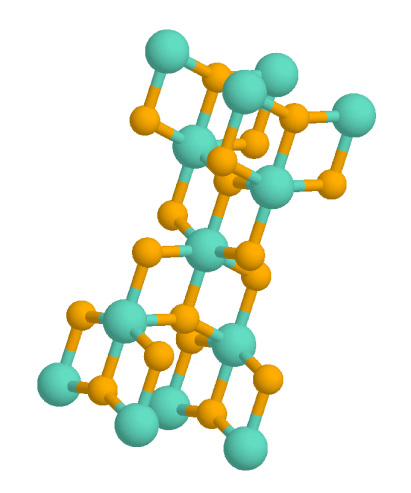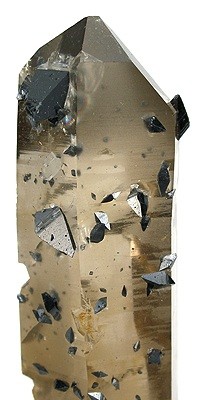anatase on:
[Wikipedia]
[Google]
[Amazon]
Anatase is a
 Two growth
Two growth
metastable
In chemistry and physics, metastability is an intermediate energetic state within a dynamical system other than the system's state of least energy.
A ball resting in a hollow on a slope is a simple example of metastability. If the ball is onl ...
mineral
In geology and mineralogy, a mineral or mineral species is, broadly speaking, a solid substance with a fairly well-defined chemical composition and a specific crystal structure that occurs naturally in pure form.John P. Rafferty, ed. (2011): Mi ...
form of titanium dioxide
Titanium dioxide, also known as titanium(IV) oxide or titania , is the inorganic compound derived from titanium with the chemical formula . When used as a pigment, it is called titanium white, Pigment White 6 (PW6), or Colour Index Internationa ...
(TiO2) with a tetragonal
In crystallography, the tetragonal crystal system is one of the 7 crystal systems. Tetragonal crystal lattices result from stretching a cubic lattice along one of its lattice vectors, so that the Cube (geometry), cube becomes a rectangular Pri ...
crystal structure. Although colorless or white when pure, anatase in nature is usually a black solid due to impurities. Three other polymorphs (or mineral forms) of titanium dioxide are known to occur naturally: brookite
Brookite is the Orthorhombic crystal system, orthorhombic variant of titanium dioxide (TiO2), which occurs in four known natural Polymorphism (materials science), polymorphic forms (minerals with the same composition but different structure). The ...
, akaogiite, and rutile
Rutile is an oxide mineral composed of titanium dioxide (TiO2), the most common natural form of TiO2. Rarer polymorphs of TiO2 are known, including anatase, akaogiite, and brookite.
Rutile has one of the highest refractive indices at vis ...
, with rutile being the most common and most stable
A stable is a building in which working animals are kept, especially horses or oxen. The building is usually divided into stalls, and may include storage for equipment and feed.
Styles
There are many different types of stables in use tod ...
of the bunch. Anatase is formed at relatively low temperatures and found in minor concentrations in igneous
Igneous rock ( ), or magmatic rock, is one of the three main rock types, the others being sedimentary and metamorphic. Igneous rocks are formed through the cooling and solidification of magma or lava.
The magma can be derived from partial ...
and metamorphic rocks. Glass coated with a thin film of TiO2 shows antifogging and self-cleaning properties under ultraviolet
Ultraviolet radiation, also known as simply UV, is electromagnetic radiation of wavelengths of 10–400 nanometers, shorter than that of visible light, but longer than X-rays. UV radiation is present in sunlight and constitutes about 10% of ...
radiation.
Anatase is always found as small, isolated, and sharply developed crystal
A crystal or crystalline solid is a solid material whose constituents (such as atoms, molecules, or ions) are arranged in a highly ordered microscopic structure, forming a crystal lattice that extends in all directions. In addition, macros ...
s, and like rutile, it crystallizes in a tetragonal system. Anatase is metastable at all temperatures and pressures, with rutile being the equilibrium polymorph. Nevertheless, anatase is often the first titanium dioxide phase to form in many processes due to its lower surface energy, with a transformation to rutile taking place at elevated temperatures. Although the degree of symmetry is the same for both anatase and rutile phases, there is no relation between the interfacial angles of the two minerals, except in the prism-zone of 45° and 90°. The common octahedral crystal habit
In mineralogy, crystal habit is the characteristic external shape of an individual crystal or aggregate of crystals. The habit of a crystal is dependent on its crystallographic form and growth conditions, which generally creates irregularities d ...
of anatase, with four perfect cleavage planes, has an angle over its polar edge of 82°9', whereas rutile octahedra only has a polar edge angle of 56°52½'. The steeper angle gives anatase crystals a longer vertical axis and skinnier appearance than rutile. Additional important differences exist between the physical characters of anatase and rutile. For example, anatase is less hard (5.5–6 vs. 6–6.5 on the Mohs scale
The Mohs scale ( ) of mineral hardness is a qualitative ordinal scale, from 1 to 10, characterizing scratch resistance of minerals through the ability of harder material to scratch softer material.
The scale was introduced in 1812 by the Ger ...
) and less dense (specific gravity
Relative density, also called specific gravity, is a dimensionless quantity defined as the ratio of the density (mass of a unit volume) of a substance to the density of a given reference material. Specific gravity for solids and liquids is nea ...
about 3.9 vs. 4.2) than rutile. Anatase is also optically negative, whereas rutile is optically positive. Anatase has a more strongly adamantine or metallic-adamantine luster than that of rutile as well.
Nomenclature
The modern name was introduced byRené Just Haüy
René Just Haüy () FRS MWS FRSE (28 February 1743 – 1 June 1822) was a French priest and mineralogist, commonly styled the Abbé Haüy after he was made an honorary canon of Notre-Dame de Paris, Notre Dame. Due to his innovative work on cryst ...
in 1801, but the mineral was known and described before. It derives from 'stretching out', because the crystals are stretched along an axis compared to other dipyramidal ones.
Another name commonly in use for anatase is ''octahedrite'', which is earlier than anatase and was given by Horace Bénédict de Saussure because of the common (acute) octahedral habit of the crystals. Other names, now obsolete, are ''oisanite'' (by Jean-Claude Delamétherie) and ''dauphinite'', from the well-known French locality of Le Bourg-d'Oisans in Dauphiné
The Dauphiné ( , , ; or ; or ), formerly known in English as Dauphiny, is a former province in southeastern France, whose area roughly corresponded to that of the present departments of Isère, Drôme and Hautes-Alpes. The Dauphiné was ...
.
Crystal habit
 Two growth
Two growth habits
A habit (or wont, as a humorous and formal term) is a routine of behavior that is repeated regularly and tends to occur subconsciously.
A 1903 paper in the ''American Journal of Psychology'' defined a "habit, from the standpoint of psychology, octahedra with an indigo-blue to black color and steely luster. Crystals of this kind are abundant at Le Bourg-d'Oisans in Dauphiné, France, where they are associated with rock-crystal, feldspar">Dauphiné">Dauphiné, France, where they are associated with rock-crystal, feldspar, and axinite in crevices in granite and mica schist. Similar crystals of microscopic size are widely distributed in sedimentary rocks such as sandstones, clays, and slates, from which they may be separated by washing away the lighter constituents of the powdered rock. The (101) plane of anatase is the most thermodynamically stable surface and thus the most widely exposed
 * Delustrant
*
* Delustrant
*
facet
Facets () are flat faces on geometric shapes. The organization of naturally occurring facets was key to early developments in crystallography, since they reflect the underlying symmetry of the crystal structure. Gemstones commonly have facets cu ...
in natural and synthetic anatase.
Crystals of the second type have numerous pyramidal faces developed, and they are usually flatter or sometimes prismatic in habit. Their color is honey-yellow to brown. Such crystals closely resemble the mineral xenotime in appearance and were historically thought to be a special form of xenotime, termed ''wiserine''. They occur attached to the walls of crevices in gneisses in the Alps
The Alps () are some of the highest and most extensive mountain ranges in Europe, stretching approximately across eight Alpine countries (from west to east): Monaco, France, Switzerland, Italy, Liechtenstein, Germany, Austria and Slovenia.
...
, a well-known locality being the Binnenthal near Brig
A brig is a type of sailing vessel defined by its rig: two masts which are both square rig, square-rigged. Brigs originated in the second half of the 18th century and were a common type of smaller merchant vessel or warship from then until the l ...
in canton Valais
Valais ( , ; ), more formally, the Canton of Valais or Wallis, is one of the cantons of Switzerland, 26 cantons forming the Switzerland, Swiss Confederation. It is composed of thirteen districts and its capital and largest city is Sion, Switzer ...
, Switzerland
Switzerland, officially the Swiss Confederation, is a landlocked country located in west-central Europe. It is bordered by Italy to the south, France to the west, Germany to the north, and Austria and Liechtenstein to the east. Switzerland ...
.
While anatase is not an equilibrium phase of TiO2, it is metastable near room temperature. At temperatures between 550 and about 1000 °C, anatase converts to rutile. The temperature of this transformation strongly depends on impurities, or dopants
A dopant (also called a doping agent) is a small amount of a substance added to a material to alter its physical properties, such as electrical or optical properties. The amount of dopant is typically very low compared to the material being do ...
, as well as the morphology of the sample.
Synthetic anatase
Due to its potential application as asemiconductor
A semiconductor is a material with electrical conductivity between that of a conductor and an insulator. Its conductivity can be modified by adding impurities (" doping") to its crystal structure. When two regions with different doping level ...
, anatase is often prepared synthetically. Crystalline anatase can be prepared in laboratories by chemical methods such as the sol-gel process. This might be done through controlled hydrolysis
Hydrolysis (; ) is any chemical reaction in which a molecule of water breaks one or more chemical bonds. The term is used broadly for substitution reaction, substitution, elimination reaction, elimination, and solvation reactions in which water ...
of titanium tetrachloride
Titanium tetrachloride is the inorganic compound with the formula . It is an important intermediate in the production of titanium metal and the pigment titanium dioxide. is a volatile liquid. Upon contact with humid air, it forms thick clouds o ...
(TiCl4) or titanium ethoxide. Often dopants are included in such synthesis processes to control the morphology, electronic structure, and surface chemistry of an anatase sample.
See also
 * Delustrant
*
* Delustrant
*Titanium dioxide
Titanium dioxide, also known as titanium(IV) oxide or titania , is the inorganic compound derived from titanium with the chemical formula . When used as a pigment, it is called titanium white, Pigment White 6 (PW6), or Colour Index Internationa ...
*Rutile
Rutile is an oxide mineral composed of titanium dioxide (TiO2), the most common natural form of TiO2. Rarer polymorphs of TiO2 are known, including anatase, akaogiite, and brookite.
Rutile has one of the highest refractive indices at vis ...
*Brookite
Brookite is the Orthorhombic crystal system, orthorhombic variant of titanium dioxide (TiO2), which occurs in four known natural Polymorphism (materials science), polymorphic forms (minerals with the same composition but different structure). The ...
* Akaogiite
* List of minerals
This is a list of minerals which have Wikipedia articles.
Minerals are distinguished by various chemical and physical properties. Differences in chemical composition and crystal structure distinguish the various ''species''. Within a mineral speci ...
References
{{Titanium minerals Titanium minerals Oxide minerals Tetragonal minerals Minerals in space group 141 Minerals described in 1801